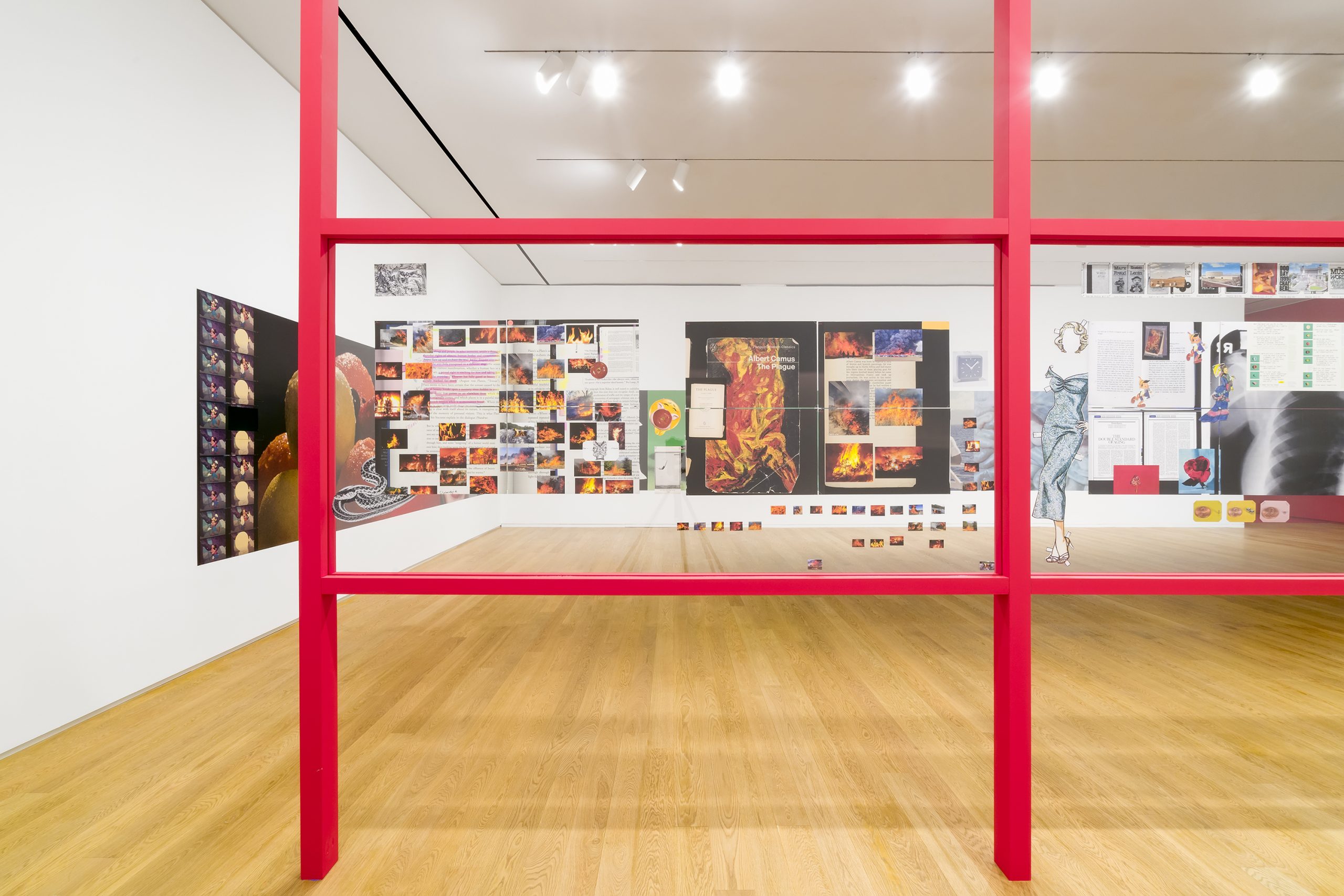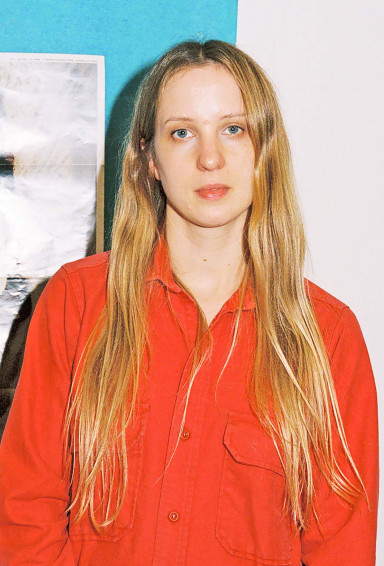Q&A
Sara Cwynar talks to Christopher Y. Lew, Chief Artistic Director, Horizon

Christopher Y. Lew
Your early work began with mind-bending photographs that combined found images with actual objects. Materials and pictures seemed to blend together. Can you speak about these “pictures of pictures”?
Sara Cwynar
At first I was very interested in truth and perception and trying to make pictures that questioned whether we could trust what we see with our eyes, and how we see each new image through a lens of what we’ve seen before, or through our own preconceived notions and biases. In my earliest work in photography, for example, in a series called Flat Death, I took many existing images, that one might consider the “tropes” of popular photography—the nature photo, the architectural shot, the smiling woman model, the commercial still life, and I would get into the surface, rework all the details so that it looked like a familiar image on first inspection, but then was not that at all once the viewer looked closer. One example includes remaking all the leaves of a nature photo out of green post-it notes! I was also thinking a lot about design and the waning of style, how the meaning and value of images change as they age and fall out of view, and what this says about our world. These ideas are still important to my work, but I think I’ve expanded on them.
Christopher
In past years you’ve begun to work with moving images and most recently presented your recent six-channel video Glass Life. Can you speak about this progression from singular, still images to multi-channel video?
Sara
I started making video because of the medium’s narrative potential. I wanted to be able to literally say more. My work is very heavily researched and there is a lot that goes into each image, but I felt that a it was getting lost in the final singular images that I was making. I have more perspective on this now, like I think that loss can actually be a good thing. But at the time it seemed like something I really needed to address. My first video was single channel, called Soft Film. It used these soft, discarded jewelry boxes that I was finding on Ebay as vessels to talk about larger more theoretical issues that I wanted to address—the slipperiness of value, nostalgia, feminism (“soft” sexism), capitalism, and how fickle capitalism can be in terms of who and what it considers important. In many ways this first film dealt with the same issues as my photos, thinking about perception and style, how the things that are made with the most optimism often fade the most quickly, and what these processes have to say about our politics and culture. I kept pushing on the videos for several years after that, making two more called Rose Gold and Red Film. And then I really began to want to make something more immersive, and multi-channelled. I wanted to make a film that echoed in its form the echo chambers and repetitions of online worlds, and how the “real” world feels against this, and that feeling of having no idea where to look or what to consider important. Multi-channel film seemed like the best way. I wanted to have different voices and characters and images speaking to each other, repeating each other, making some ideas float to the top and others fade to the background, much as the internet and its algorithms does. I also wanted to make something more personal, and connected to an actual life, the medium of video in this regard allowed me to include more quiet, personal footage that I had shot—a donkey, a view from a bus, the contents of my iPhoto, to make it feel like more than an object lesson about the internet, and to move into something that is about our actual lives and how these things press upon it.
Christopher
Aside from the photographs and footage you’ve taken yourself, how do you go about gathering the images for these works and is there something particular in a found photograph that gives you pause?
Sara
I am constantly saving and archiving things I see every day. I can’t turn it off! But I also have a sort of top 500 (or so) list of collected archival images that I am always returning to. Things like, a picture of a 1940s Portuguese crown, a bunch of 16th century armors photographed in the 1950s, an ad for stuffed animals, a set of pictures of gum display stands, pictures of birds. I want to mix newer contemporary photos with the old ones to show the systems that dictate importance and relevance in the current moment, how things repeat, and how they influence how we understand ourselves and our history. These processes are trying to keep something going, to maintain the status quo, to show us back the values that would be convenient for us all to accept as described by capitalism, patriarchy, by power essentially. And then I want to mix newer images with those old ones to show how these things don’t really change, to show that no matter how much progress we think we are making (or thought we were making), we are actually surrounded by the same process, with the same effects. I also don’t want it to be quite so negative. I think a lot about the visual pleasure in found photographs, the pleasure involved in feeling nostalgia, and desire can be important in helping us stay connected to the world, and attached to things that keep us moving forward. I think that found photographs, particularly of the mid-century era that I am often very interested in mixing into my work, show us a lot of those desires and how they have worked out.
Christopher
Can you speak about your artistic influences? I know the Pictures generation of appropriation artists is an important foundation. I also see you as part of a younger generation of artists investigating the relationship between images and objects as well as how pervasive pictures are in this century.
Sara
I really love Sarah Charlesworth, and Cindy Sherman, and various other Pictures generation artists. I think that the way they re-appropriated existing source materials felt really freeing to me when I first saw it. Now I am trying to think about how this exists in the current moment, when things are being re-appropriated and re-contextualized and used for things other than their original intention at an ever more rapid pace all around us. To this extent I find a lot of writers who talk about these forces really inspiring, like Patricia Lockwood recent book No One is Talking about This, Andrea Long Chu’s work, or actually the writing of the model Emily Ratajkowski has really hit the nail on the head in terms of the lives of images, and particularly images of women in our time, how they circulate and get away from the people shown in them. Some of my favorite artists that I looked at a lot as influences, who were just a little bit before me and really changed what I thought photography could do were Leslie Hewitt, Moyra Davey, Annette Kelm, Lucas Blalock. Some of these artists are friends now! But when I was starting to make work these artists work got me thinking about what photos and videos do and how they work on us, and also about questions relation to their potential for truth-telling. Plus the idea that a photo doesn’t have to be super high produced with a whole crew for it to be worth looking at, or to be considered art.
Christopher
Residencies like Horizon afford artists with time and studio space. Can you tell us what you plan to do with that time and space?
Sara
I have so many ideas for this amazing space and the location of being in LA. I really want to make a film that could only be made with longer term access to a large space. I have some ideas about renting a very long conveyor belt and making long single shots with it, or working with a movie prop house to build an elaborate set that can be used over and over again in different ways. I think there is a lot available in LA that makes sense for my work, I’m very excited about the possibilities


